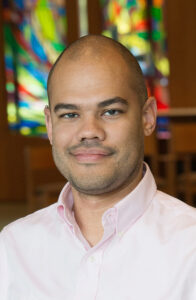
Embodied Teaching at a Distance
Before March 2020, the seminary where I teach didn’t do much in the way of remote learning. Like many educators, my colleagues and I found ourselves rushing to take our teaching online at the same time that many of our students were taking courses remotely for the first time. My colleagues and I found this new mode of teaching terribly awkward. Most of them found that awkwardness frustrating.
Not me, though. I was gifted from childhood with a certain awkwardness. It’s cozy.
Still, the awkwardness of remote learning wasn’t the only concern being raised in faculty meetings, especially as we were discerning the extent to which we would offer remote learning going forward. That awkwardness was increasingly framed as the consequence of a claim that had more weight behind it in conversations about theological education: that remote learning was disembodied.
It seems obvious. When teachers and students aren’t in the same space, but instead find our interactions mediated by a screen and who knows how many miles of cables or electromagnetic waves of various sorts, our teaching and learning are necessarily disembodied. We lose the nonverbal feedback on which we so often rely in conversation. The flow of our class discussions becomes awkward, either with one person talking over another or with everyone raising their virtual or physical hands and waiting just a little too long to be called on. It is difficult to keep students’ attention for hours on end if we aren’t physically in person, and it’s hard to foster that sense of classroom community that often grows over the course of a term.
It seems obvious that remote learning is necessarily disembodied learning… but that’s not actually the case. Everything we do, we do as creatures of flesh and blood, pain and pleasure, energy and fatigue. When our teaching and learning aren’t practiced in a shared physical space, they are nonetheless practiced in physical spaces that meaningfully impact our learning, in bodies that each have their own mix of needs and abilities. Our reception, processing, and expression of ideas are embodied processes, wherever our bodies happen to be in relation to one another. Intellectual, emotional, and spiritual engagement with teaching and learning happens within and between bodies.
Remote learning is not necessarily disembodied. It just turns out that teaching techniques designed to harness one form of embodiment don’t always translate well to a significantly different form of embodiment.
If we can accept that no teaching and learning are necessarily disembodied, but that they must be embodied differently, it is possible to turn what feels like disembodied teaching and learning into teaching and learning that are embodied in particularly meaningful ways. For those who—like me—continue to wonder just what it means to engage in embodied teaching at a distance, I offer three suggestions:
- Let go of the need for controlled learning environments in favor of precisely the kind of adaptability students will need in their own work. Consider how you might model and promote such adaptability in your teaching.
- Reflect on the value of people working in their everyday spaces (e.g., offices, homes), rather than the constructed space of the in-person classroom. Discern how you might invite people to treat their everyday spaces as spaces for learning just as they are, rather than as something out of which learning space must be carved.
- Re-commit to the truth that being embodied together in ways that promote rich learning—marked by equity no less than serious intellectual engagement—requires intentional practices of community formation, whether we’re in the same physical space or at a distance.
Leave a Reply